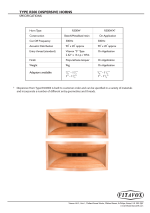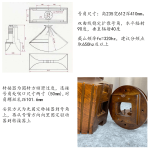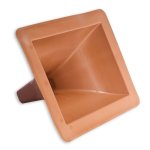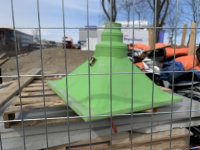for those who wanted to try the RCF ND 850 2.0 and cant' find them in 2 inch ( out of stock in E.U Joseph Crowe review ? 😀 ) you can buy the 1.4 model and use the 18sounds ADAPTOR-14-20-V2 (it has the same length as the RCF ones ) .
i will try them next week if they can really do 500/10K as clean as the youtube review ..😉
i will try them next week if they can really do 500/10K as clean as the youtube review ..😉
I did not know Blumenhofer, I would be very intesting to hear them. It looks like the basic scheme is crossing at 750-850hz (with the bigger midwoofers) and using "waveguides" for the mids (I don't know how much loading those short horns can have on the driver). The HF horns seem to be small for the crossover frecuency. From your aswer to my question, I understand they use third order on both HP and LP.Well spotted 😉
Blumenhofer speakers clearly deviate from the mainstream. The founder/owner/designer is a man of few words, but he possesses knowledge, experience and urge to create.
Have you had the chance to hear the models not using a waveguide/horn for the mids? I ask because that might reveal how much of the magic comes from using them.
Last edited:
You mean the waveformer ~ waveguide in front of the woofers?
Yes, I've also listened to the 'basic' models with direct radiating woofer and compression driver + waveguide.
Aside from Dr. Geddes' Summa, I took inspiration of these bigger BH models for my 2-way system, but added a few ingredients of my own.
BH uses fairly small horns and waveguides and doesn't aim for the lowest crossover except for his largest specialty products.
To make up for the lack of horn loading, he uses larger drivers, with the ND850 1.4 being one of his favourites.
The result is a 2-way that doesn't sound like a typical horn speaker, but rather like a mini monitor on steroids.
Listen yourself (one of the few YT channels where the guys know how to properly record speaker systems in a room):
Yes, I've also listened to the 'basic' models with direct radiating woofer and compression driver + waveguide.
Aside from Dr. Geddes' Summa, I took inspiration of these bigger BH models for my 2-way system, but added a few ingredients of my own.
BH uses fairly small horns and waveguides and doesn't aim for the lowest crossover except for his largest specialty products.
To make up for the lack of horn loading, he uses larger drivers, with the ND850 1.4 being one of his favourites.
The result is a 2-way that doesn't sound like a typical horn speaker, but rather like a mini monitor on steroids.
Listen yourself (one of the few YT channels where the guys know how to properly record speaker systems in a room):
Last edited:
would adding some damping material just on top of the suspension help at all? I would think that a viscose elastic layer on the surround would permit excursion yet damp any resonance. Has anyone gone down this rabbit hole? I have seen aquaplas covering the diaphragm and the suspension as well so it would seem to be beneficial.The JBL "diamond" surround spread out the surround resonance over a wider bandwidth, but it had issues of its own (which obviously JBL decided to gloss over in their marketing blurb...)
Those guys have also uploaded a few videos of the Magico M9s... While these aren't bad speakers, I certainly wouldn't say they sound $700,000 better than the BHs. On the contrary, I can (even) perceive the same synthetic, clinical signature that I also experienced when listening to the smaller M2s.You mean the waveformer ~ waveguide in front of the woofers?
Yes, I've also listened to the 'basic' models with direct radiating woofer and compression driver + waveguide.
Aside from Dr. Geddes' Summa, I took inspiration of these bigger BH models for my 2-way system, but added a few ingredients of my own.
BH uses fairly small horns and waveguides and doesn't aim for the lowest crossover except for his largest specialty products.
To make up for the lack of horn loading, he uses larger drivers, with the ND850 1.4 being one of his favourites.
The result is a 2-way that doesn't sound like a typical horn speaker, but rather like a mini monitor on steroids.
Listen yourself (one of the few YT channels where the guys know how to properly record speaker systems in a room):
with 700000$ i will buy a 690000$ House and build a 9900$ hifi sytem souding as good as the MAgico"s and even save 100$ for the mother"s day tomorow taking my wife to the restaurant 🤔
Last edited:
What's your thoughts on TAD replica horn on tabbao?
There are few shops selling similar looking horns. Are the Yuichi horn still good option nowadays?
Such as this one. Would be ~310 USD. The smaller 450Hz cutoff one is even cheaper ~180USD. The original graph is already heavily compressed

Or this one
This one even has some formula in its description
What's the crossover frequency TAD use when using 290/480 Hz horn? The page above suggest 300 Hz cutoff to cross at ~600Hz, and the 480 Hz cutoff one to cross at ~900Hz.
Is the crossover frequency set to 2X the cutoff frequency the typical crossover setting?
According to Troy (Joseph Crowe) his ES horn improve the Yuichi horn and don't need the dispersion fins. The time domain behavior is also improved.
Not sure which one to go.
The CNC shop I asked on taobao that can fabricate the ES horn only have beech or oak. No plywood option and cause about 420 USD for ES-600 horn.
And I've also ask 3 CNC shops in Taiwan that can do with plywood but the price is doubled or higher.
How on earth taobao can make it so cheap.
There are few shops selling similar looking horns. Are the Yuichi horn still good option nowadays?
Such as this one. Would be ~310 USD. The smaller 450Hz cutoff one is even cheaper ~180USD. The original graph is already heavily compressed
Or this one
This one even has some formula in its description
What's the crossover frequency TAD use when using 290/480 Hz horn? The page above suggest 300 Hz cutoff to cross at ~600Hz, and the 480 Hz cutoff one to cross at ~900Hz.
Is the crossover frequency set to 2X the cutoff frequency the typical crossover setting?
According to Troy (Joseph Crowe) his ES horn improve the Yuichi horn and don't need the dispersion fins. The time domain behavior is also improved.
Not sure which one to go.
The CNC shop I asked on taobao that can fabricate the ES horn only have beech or oak. No plywood option and cause about 420 USD for ES-600 horn.
And I've also ask 3 CNC shops in Taiwan that can do with plywood but the price is doubled or higher.
How on earth taobao can make it so cheap.
Attachments
Do you know what woofer he uses?You mean the waveformer ~ waveguide in front of the woofers?
Yes, I've also listened to the 'basic' models with direct radiating woofer and compression driver + waveguide.
Aside from Dr. Geddes' Summa, I took inspiration of these bigger BH models for my 2-way system, but added a few ingredients of my own.
BH uses fairly small horns and waveguides and doesn't aim for the lowest crossover except for his largest specialty products.
To make up for the lack of horn loading, he uses larger drivers, with the ND850 1.4 being one of his favourites.
The result is a 2-way that doesn't sound like a typical horn speaker, but rather like a mini monitor on steroids.
Listen yourself (one of the few YT channels where the guys know how to properly record speaker systems in a room):
For the older models he used Eton (for the smaller speakers), GPA and TAD.
Custom woofers have been developed in cooperation with Norman Gerkinsmeyer (ATE).
The smaller woofers feature sandwich cones which are highly damped > no breakup.
Custom woofers have been developed in cooperation with Norman Gerkinsmeyer (ATE).
The smaller woofers feature sandwich cones which are highly damped > no breakup.
What's your thoughts on TAD replica horn on tabbao?
There are few shops selling similar looking horns. Are the Yuichi horn still good option nowadays?
Such as this one. Would be ~310 USD. The smaller 450Hz cutoff one is even cheaper ~180USD. The original graph is already heavily compressed
View attachment 1180320
Or this one
This one even has some formula in its description
What's the crossover frequency TAD use when using 290/480 Hz horn? The page above suggest 300 Hz cutoff to cross at ~600Hz, and the 480 Hz cutoff one to cross at ~900Hz.
Is the crossover frequency set to 2X the cutoff frequency the typical crossover setting?
According to Troy (Joseph Crowe) his ES horn improve the Yuichi horn and don't need the dispersion fins. The time domain behavior is also improved.
Not sure which one to go.
The CNC shop I asked on taobao that can fabricate the ES horn only have beech or oak. No plywood option and cause about 420 USD for ES-600 horn.
And I've also ask 3 CNC shops in Taiwan that can do with plywood but the price is doubled or higher.
How on earth taobao can make it so cheap.
Prices of baltic birch have at least tripled.
600 Hz is a safe xo freq. for 300 Hz cutoff, depending on the driver.
420 USD is peanuts compared to £3,649.80 for this (beech) Vitavox W300:

Last edited:
Thank you for the info😉For the older models he used Eton (for the smaller speakers), GPA and TAD.
Custom woofers have been developed in cooperation with Norman Gerkinsmeyer (ATE).
The smaller woofers feature sandwich cones which are highly damped > no breakup.
@Ro808 I share your assessment of the Blumenhofers, everything I've heard at shows has left a very positive impression. I have questions about some of their design points, such as the rather high crossover, but whatever the case, they sound great. IMHO it was probably the best sound at the last Warsaw exhibition.

It's interesting to listen to good recordings with quality microphones, but I wish there were recordings on something like an iPhone, so we could easily compare to home recordings. Just for fun recorded this track on my phone (my whole system might be cheaper than their RECORDING system, LOL))
Listen yourself (one of the few YT channels where the guys know how to properly record speaker systems in a room):
It's interesting to listen to good recordings with quality microphones, but I wish there were recordings on something like an iPhone, so we could easily compare to home recordings. Just for fun recorded this track on my phone (my whole system might be cheaper than their RECORDING system, LOL))
Is that HF950 horn?
Seems that the woofer is 18", is it still good to cross a 18" woofer that high?
Seems that the woofer is 18", is it still good to cross a 18" woofer that high?
Yep, 950 horns and 940 drivers and 18'' Faitals. Cross at ~600.Is that HF950 horn?
Seems that the woofer is 18", is it still good to cross a 18" woofer that high?
Is it good - it depends... Purists will not approve this (without listening))) I'm happy with all of them.
Very interesting concept and from the video it sounds decent too!Is it good - it depends... Purists will not approve this (without listening))) I'm happy with all of them.
Another interesting and relatively affordable 3" driver (1.4" exit), made in Italy of course:


Attachments
Last edited:
I wish too, especially from fellow forum members, to actually being able to have a listen to their system instead of trying to understand how it sounds by using language.It's interesting to listen to good recordings with quality microphones, but I wish there were recordings on something like an iPhone, so we could easily compare to home recordings.
- Home
- Loudspeakers
- Multi-Way
- Best Compression Drivers today 2022?


